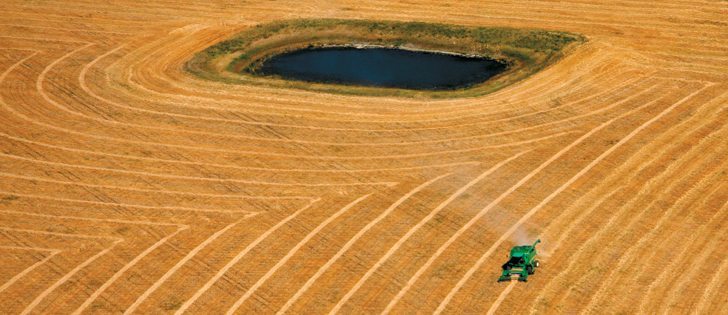Drought and then late season rain will complicate harvest plans as late flush of second growth makes a mess of fields
The phrase “ green is the colour” has taken on a new meaning in some parts of Saskatchewan this year.
Normally used by Saskatchewan Roughrider football fans, the phrase is being used this year to describe durum crops across much of the province’s southwest.
From Moose Jaw to Kindersley and most points south, producers are looking at durum fields with a late flush of dense, green second growth.
“There’s definitely a lot of variability out there when it comes to crop staging,” said Jeremy German, lead agronomist with G-Mac’s Ag Team Inc. at Kindersley, Sask.
Read Also

Farming Smarter receives financial boost from Alberta government for potato research
Farming Smarter near Lethbridge got a boost to its research equipment, thanks to the Alberta government’s increase in funding for research associations.
“They say a half inch of rain after seeding makes everybody a perfect farmer, but in a lot of cases, we didn’t get a decent rain until the last week in July, nearly 60 days after seeding was completed.”
Durum growers across much of southwestern Saskatchewan will be harvesting durum with two, three and sometimes four different stages of plant growth in the same field.
Extremely dry seeding conditions in late April and May were followed by drought conditions throughout June and most of July.
Germination was poor in many fields and plant stands were extremely thin.
Many fields produced a vigorous flush of second growth when rain finally arrived in late July and early August.
“There’s some fields where we’ve seen 30 percent of the crop coming up (in the first flush) and as much as 70 percent coming up later,” German said.
“In some fields, the late stuff looks fantastic … but it’s still very green and now we’re racing against Mother Nature to beat that first killing frost.”
For a good part of southwestern Saskatchewan, the first killing frost does not occur on average until the second or third week in September.
In the Kindersley area, the long-term average for the first killing frost is between Sept. 22 and Sept. 24.
However, fields that produced a second flush of durum in late July are unlikely to reach maturity until well into October.
“We usually call durum a 108-day crop in southwest Saskatchewan,” German said.
“It’s pretty unlikely likely that those (late) fields will reach maturity before the first frost.”
German’s advises growers to assess fields and determine what percentage of yield potential is comprised in advanced or mature plants, as opposed to late or immature plants, and make harvest management decisions based on those assessments.
For producers whose fields contain 70 percent second growth and 30 percent mature plants, the potential rewards of waiting on the second flush to come in is relatively high.
But for growers whose fields contain 70 percent of potential yield in early emerging or mature plants, the potential benefits of waiting to harvest are relatively low.
In either case, the decision to wait can carry a significant financial risk.
If the weather doesn’t co-operate, growers who are already expecting reduced yields could find themselves harvesting that small crop with poor quality.
“The biggest risk is losing grade,” said German.
“The longer you leave that crop in the field, the greater your susceptibility to bleaching … sprouting and some of the fungal seed diseases such as smudges and black points.”
According to the Canadian Grain Commission, a lot of the early durum that has been harvested in southwestern Saskatchewan has been making top grades.
Growers who abandoned the notion of harvesting late material were rewarded with a small but high quality harvest.
German said many producers have opted to minimize risk by applying a pre-harvest chemical.
In addition to drying down the crop, pre-harvest applications will also deliver the added benefit of controlling late emerging weeds, which are common in many cereal fields this year.
Swathing is another option.
Before applying desiccants, producers should ensure that the products they are using are approved for use as a pre-harvest aid in Canada.
Growers should also inquire about maximum residue limits to ensure they have been established for the products they are using.
In some cases, MRLs have not been established for products that have been approved for use as a pre-harvest aid.
Contact brian.cross@producer.com


















